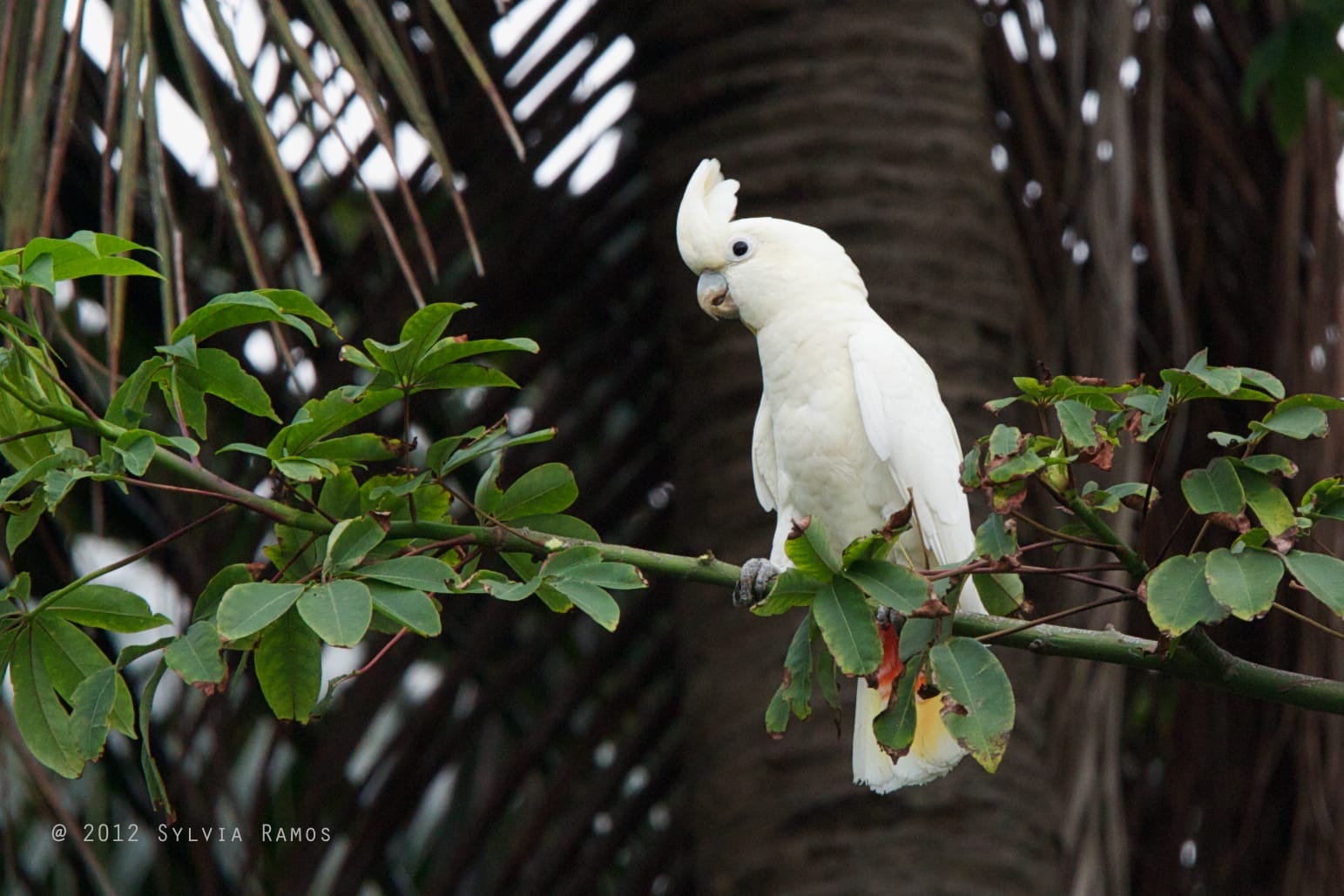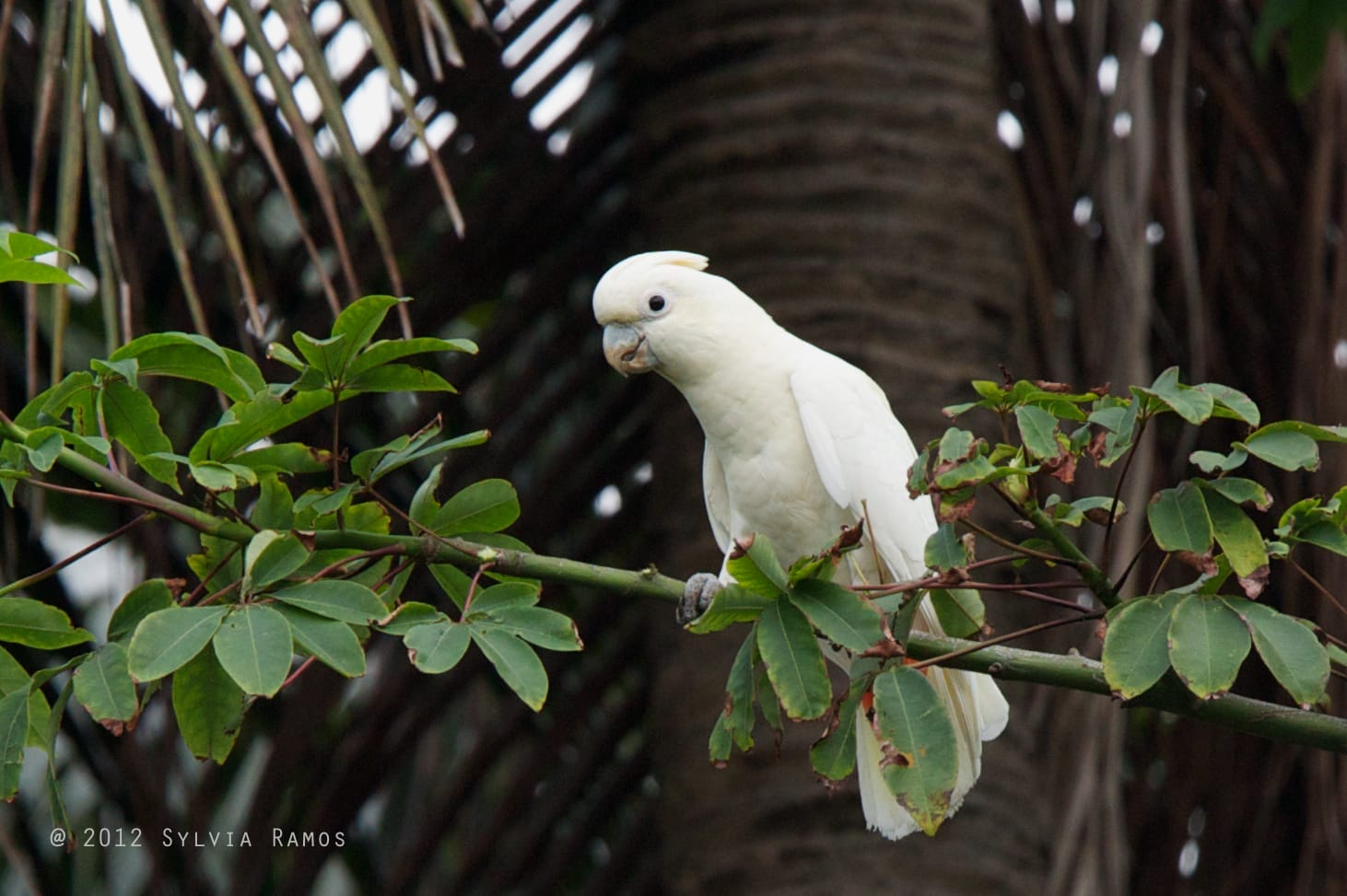A slightly edited version of this article was featured as a cover story of the August 2013 issue of Animal Scene magazine, a monthly magazine published by Manila Bulletin. The magazine caters to all kinds of animal lovers — pet owners, conservationists, and now possibly a few new birders.
—-
The Philippine Cockatoo: Grasping for Survival
photos and text by Sylvia Ramos
—

Philippine Cockatoos (Cacatua haematuropygia) are found only in the Philippines. And they’re disappearing right before our eyes. In the past 30 years the population of Philippine Cockatoos in the wild has plummeted from tens of thousands to barely one thousand at present. They have gone from being a common sight throughout most of the Philippines to a critically endangered bird with remnant populations in a few scattered sites. The Philippines is the Philippine Cockatoo’s only home. Once they disappear from our forests, they cannot be replaced.
The Philippine Cockatoo is a beautiful bird. While all of the other birds from the parrot family that are found in the Philippines are green, the Philippine Cockatoo is a resplendent white. It even has the distinction of being the only white large land bird in the Philippines. The Philippine Cockatoo is 305 mm (12 inches) long with tinges of yellow and pink on its cheeks, and yellow on its underwing, and reddish orange on its undertail. The males have dark brown eyes and the females have blood red eyes. Both male and female Cockatoos have big crests on top of their heads that can be flexed up and down depending on the mood of the Cockatoo. The crest is like an indicator of emotions, standing erect when the Cockatoo is excited or provoked and laying flat when it is relaxed. The Philippine Cockatoo also has a chalky white to greyish white bill that is big and curved like a typical parrot bill. Its bill and tongue are like an extra set of dexterous fingers that are used not just to pick up food but also to grasp branches as it climbs up and down a tree.


So many things about the Philippine Cockatoo have set it on a collision course with humans. And so far, the birds have taken a huge hit. To start with, they like to live in the coastal plains where most people also like to live. Then instead of flying silently from tree to tree, they like to gather together in big, noisy, and conspicuous groups. Then they have also been known to gather in flocks to raid rice and corn fields. And to cap it off, they are beautiful, cute, playful, curious, and they can mimic language. With all that, it seems the Philippine Cockatoo is fated to either be captured as a pet or killed as a pest. Either way, it seems that people have pushed the Philippine Cockatoo to the brink of extinction.
In A Guide to the Birds of the Philippines by Robert Kennedy et al, it says that the Philippine Cockatoo “may be the most threatened species in the Philippines with nearly every known nest robbed each year to supply the pet trade.” The Philippine Cockatoo is categorized as Critically Endangered by the International Union for Conservation of Nature (IUCN). This is the highest danger level that the IUCN has and means that among other things, they estimate that “the probability of extinction in the wild is at least 50% within 10 years or three generations, whichever is the longer (up to a maximum of 100 years)”.
The situation of the Philippine Cockatoo is dire. The only remaining populations in the wild are found in Polillo group of islands, Samar, Bohol, Tawi Tawi and Palawan. There are fewer than 20 individuals in the Polillo group of islands and Samar. The population in Sulu has not been surveyed because of security issues, but estimates put the population at less than two hundred. The rest of the Philippine Cockatoo population of about 750 individuals is found in Palawan.
It took human intervention to put the Philippine Cockatoo population in such dire straits and it will also take human intervention to help them recover. In Palawan, the number of Cockatoos has increased over the past few years unlike the downward spiral in the rest of the country. This is mainly due to the efforts of the Katala Foundation (www.philippinecockatoo.org). The foundation is named after the local name for the Philippine Cockatoo. It is a Philippine-based foundation headed by Peter Widmann and Indira Lacerna-Widmann. The foundation runs several programs including Palawan Pangolin research, Philippine Freshwater Turtle Conservation Program, and the Philippine Cockatoo Conservation Program (PCCP). PCCP has four project sites in Palawan: Rasa Island; Dumaran; Pandanan, Balabac; and Rizal, Palawan and one in Southern Luzon in the Polillo Group of Islands. Their first project site was Rasa Island. When they began in 1998 there were only 23-25 Philippine Cockatoos. By 2008 the population had increased to more than 200 individuals! All in a tiny coral island off mainland Palawan that measures 8 square kilometers.
Early on, the Katala Foundation discovered that a crucial component of their conservation program was identifying the poachers and convincing them to become part of the program as wardens. This was easy to do at Rasa because each poacher made it known to one and all that he was the “owner” of a particular nest, which he would “harvest” at the appropriate time. There was no fear of persecution because wildlife protection laws were not being enforced. The entire Cockatoo population of Rasa was “owned” by 9 poachers from the Tagbanua tribe. The poachers were convinced to give up a seasonal windfall for a smaller but steadier income as a warden. These wildlife wardens are paid partially by the local government of Narra through an annual appropriation.
Once the poachers had been converted into wardens, then there was an immediate benefit. The fate that year’s batch of Cockatoo nestlings was secured. They would have a chance to grow up as wild and free Philippine Cockatoos. The poachers turned wardens were also able to contribute to the conservation program in many other ways. They turned out to be very well qualified to do field work. They could identify trees that the Cockatoos preferred for food and for nesting, collect herbarium specimens, and make reports. When there was an extended dry season and the nestlings had to be given supplemental feeds, the wardens were the only ones capable of climbing the tall nesting trees three times a day to give the feed!
Every site had its own particular issues. When PCCP started up at Dumaran, they discovered that unlike in Rasa, the poachers there were not good at climbing trees. So instead of climbing up a tree to raid a nest, they would just chop down the entire tree! Usually, these are mature trees that are also highly valued as timber. The loss of big, mature trees suitable for nesting has a huge impact. Often it results in the death of an entire Cockatoo family. Other birds that nest in tree cavities like the Palawan Hornbill and Blue-naped Parrot are also affected. It takes decades for a suitable tree species to reach the size required by birds for nesting. Tree planting is good, but not as an immediate solution. In the meantime, PCCP also attempted remedial measures like setting up artificial nest boxes. So far, the nest boxes have been unsuccessful. They discovered that while the Philippine Cockatoo can easily adapt its diet and habits to changes in the environment, it is still a traditionalist when it comes to nesting.
Like many other birds, Philippine Cockatoos are extremely long-lived. There are no studies of longevity in the wild of Philippine Cockatoos. Records of captive birds show that Philippine Cockatoos can live for more than 40 years, sometimes up to 60 years old. This means that it is possible to have an area where the bird population is composed entirely of adult birds that are not breeding or nesting. Then when these birds die, the population will suddenly nosedive and eventually disappear since there is no population of younger birds to take the place of the older birds. That is why intact nest trees are so important. As long as the nest trees remain intact, then the population has a chance for survival.
Another key component of the conservation program was gaining the cooperation of the community. Philippine Cockatoos are not forest skulkers. They do not hide deep in the woods. They are found in the same places where people like to settle. The community was shown that taking care of their environment benefitted them as well as the Philippine Cockatoo and other wildlife. In one of PCCP’s early campaigns in Dumaran, they distributed posters throughout the community titled “Share a Place to Live”. The posters showed that forests serve as watersheds, prevent droughts, prevent floods, and provide drinking water. Mangroves benefit fishermen and the entire community because they serve as fish nurseries and natural water filters. The poster also illustrated how common practices like slash and burn or kaingin where forests are cleared for cultivation or to convert to pasture, logging, and cutting down trees to make charcoal are harmful to both people and wildlife because it deprives wildlife of a place to live and leads to destructive floods in the community.

The PCCP and the community need constant vigilance against threats to their welfare and the welfare of the Philippine Cockatoo and other wildlife. In June 2013, the municipal council of Narra filed a resolution opposing a 15-megawatt coal-fired power plant proposed to be built in Barangay Panacan by DMCI Power Corporation. The power plant was to be located only 700 meters away from the sanctuary. The power plant would block the flight path of the Cockatoos, possibly electrocute them along the power lines, pose health risks for the local residents, and have negative effects on the marine ecosystem.
The Philippine Cockatoo is worth saving. It is a unique and amazing bird that is found only in the Philippines. Every year groups of birdwatchers come from all parts of the world to see the Philippine Cockatoo in the wild. Many groups go to Narra, the mainland across from Rasa Island. At daybreak, the birdwatchers stand at the shore to watch the flocks of Philippine Cockatoos stream towards Narra to feed on the Moringa oleifera or malunggay trees that the residents have been planting over the years during the annual Katala Festival. The residents are used to seeing Cockatoos and birdwatchers by now. They are like tourist guides, steering the visitors to the trees that the Cockatoos have chosen to perch on that day. One of the residents beckons to the visitors. She wants to show them something special inside her yard. It’s a malunggay tree. You can hear the pride in her voice as she points out that her tree is already so scraggly and bare that she can hardly harvest from it. The Cockatoos came back to her tree again and again the previous week to feast on the seedpods. A wild Philippine Cockatoo nonchalantly feeding on a tree in a front yard. Perhaps that’s what it was like all over the country 30 years ago when Cockatoos were common. And perhaps one day there will be more and more places like that. Places that both people and Cockatoos can call home.


If you would like to find out how you can help the Philippine Cockatoo, please visit the website of Katala Foundation at www.philippinecockatoo.org

Pingback:October 2013 | e-BON
very sad news but at the same time it is nice to know that our very own philippine cockatoo is being looked after. i hope it continues its success.
The key is getting more people to be aware and then to care.